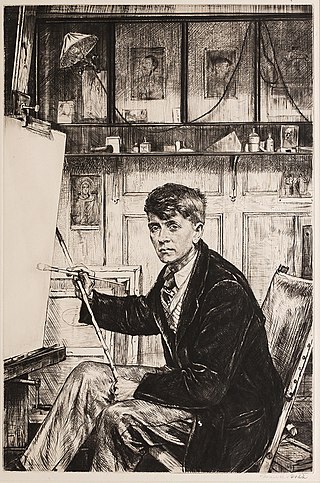Frank Owen Dobson CBE was a British artist and sculptor and during his time was considered one of the best sculptors in Europe. He was a contemporary of Jacob Epstein and Henry Moore.
Carel Victor Morlais Weight, was an English painter.

Alan Ernest Sorrell was an English artist and writer best remembered for his archaeological illustrations, particularly his detailed reconstructions of Roman Britain. He was a Senior Assistant Instructor of Drawing at The Royal College of Art, between 1931–39 and 1946–48. In 1937 he was elected a member of the Royal Watercolour Society.
Carol Wyatt is a British artist known as a painter and for her stage designs for opera productions.

Winifred Margaret Knights was a British painter. Amongst her most notable works are The Marriage at Cana produced for the British School at Rome, which is now in the Museum of New Zealand Te Papa Tongarewa and her winning Rome Scholarship entry The Deluge, which is now held by Tate Britain. Knights' style was much influenced by the Italian Quattrocento and she was one of several British artists who participated in a revival of religious imagery in the 1920s, while retaining some elements of a modernist style.
Roland Vivian Pitchforth RA ARWS was an English painter, teacher and an official British war artist during the Second World War. He excelled at watercolours and in later years concentrated on landscapes, seascapes and paintings of atmospheric effects.
Richard Ernst Eurich, OBE, RA was an English painter who worked as a war artist to the Admiralty in the Second World War and was also known for his panoramic seascapes and narrative paintings. These were often invested with a sense of mystery and wonder which have tended to set him apart from mainstream development of art in the twentieth century.
John Cecil Stephenson was a British abstract artist and pioneer of Modernism.

Reginald Grenville Eves was a British painter who made portraits of many prominent military, political and cultural figures between the two world wars.
Stella Schmolle, was a British painter, known for the paintings she produced while serving in the Auxiliary Territorial Service during World War II and for her post-war portrait paintings.
The War Artists' Advisory Committee (WAAC), was a British government agency established within the Ministry of Information at the outbreak of the Second World War in 1939 and headed by Sir Kenneth Clark. Its aim was to compile a comprehensive artistic record of Britain throughout the war. This was achieved both by appointing official war artists, on full-time or temporary contracts and by acquiring artworks from other artists. When the committee was dissolved in December 1945 its collection consisted of 5,570 works of art produced by over four hundred artists. This collection was then distributed to museums and institutions in Britain and around the world, with over half of the collection, some 3,000 works, going to the Imperial War Museum.

Charles Ernest Cundall,, , was an English painter of topographical subjects and townscapes, best known for his large panoramic canvases.
John Edgar Platt was an English painter, woodcut artist and designer of stained glass. His work was part of the art competitions at the 1928 Summer Olympics and the 1948 Summer Olympics.
Leonard Appelbee,, was an English painter and printmaker, most notable for his portraits and still-life paintings.
Walter John Bayes was an English painter and illustrator who was a founder member of both the Camden Town Group and the London Group and also a renowned art teacher and critic.
Michael Ford was an English artist who worked in several media and whose paintings often have a somewhat naive quality coupled with elements of minute, detailed observation.
John Rutherford Armstrong was a British artist and muralist who also designed for film and theatre productions. He is most notable for the Surrealist paintings he produced.
Robin Craig Guthrie, was a British artist. He painted portraits, landscapes and murals and was also a draughtsman and book illustrator.
Cyril Mahoney, known as Charles Mahoney, was a British artist and teacher, known for his large-scale mural work.
Frank Barrington Craig, also known as Barry Craig, was a British painter of portraits and landscapes and also an art teacher.






